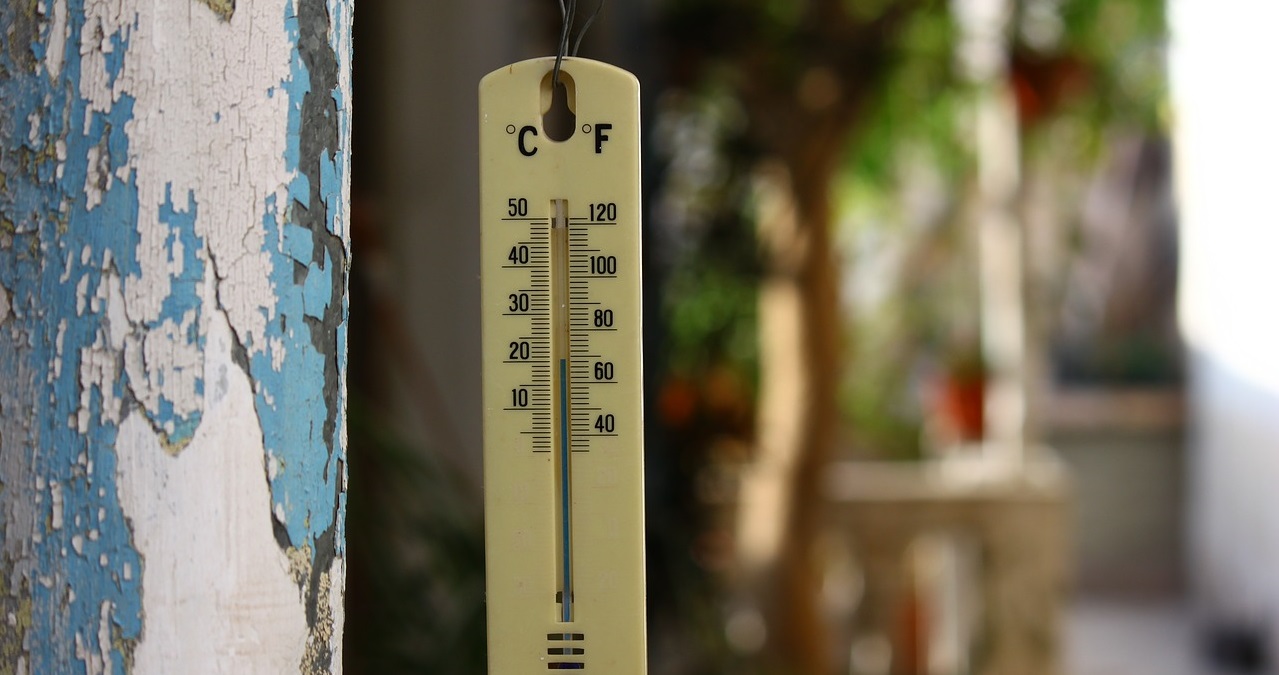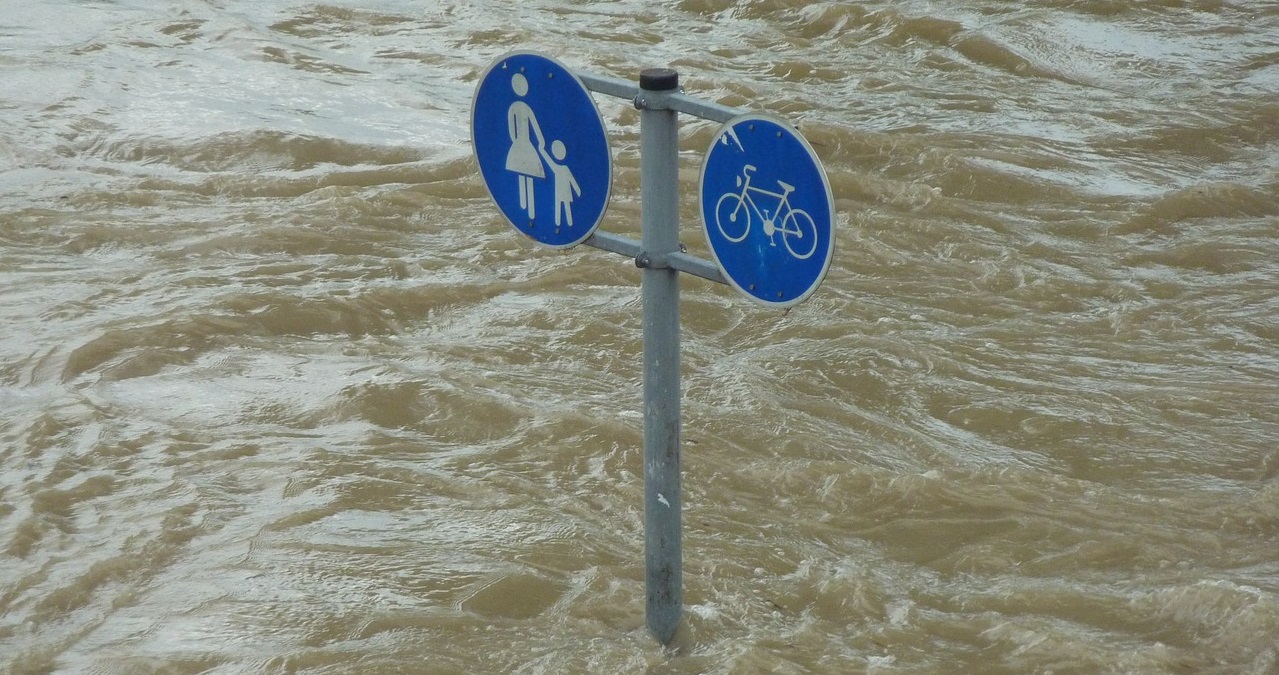气候变化与古代文明
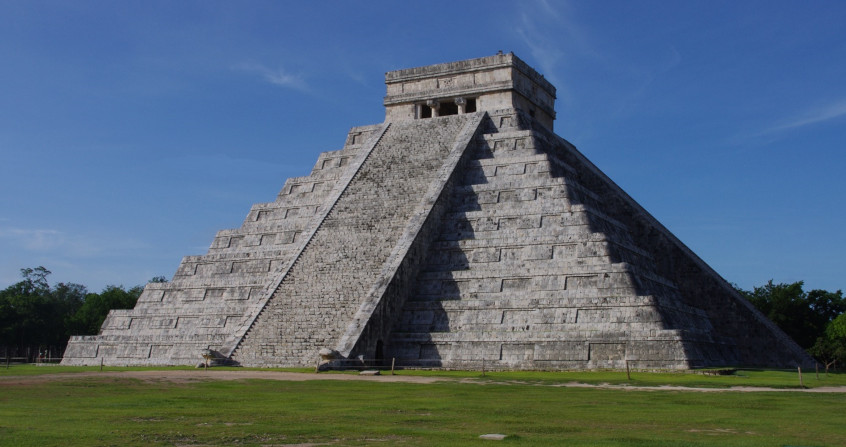
历史上辉煌文明的兴衰往往与气候条件的变化紧密相连。这样的联系是有意义的:正常的农业生产对历史文明发展至关重要,而农业生产对气候条件的变化(尤其是水资源供应)十分敏感。通过考古学家的工作我们能更好地了解这些文明的历史;而古气候学的研究则帮助我们重建过去的气候变化,并将水平衡的变化与可能改善或降低人类生境的变化联系起来。本文列举了一些案例来阐述历史时期人类定居点的变化与过去千年标志性气候变化事件之间的联系,并据此提出问题:反复出现的干旱事件如何导致苏美尔和玛雅文明走向衰亡?小冰期对欧洲和亚洲部分地区的人口有何影响?
1. 第一批古城的出现受益于气候条件
宏伟的古城通常是原始文明的中心。从世界地图上看,它们之中的大部分都位于热带地区(图1)。这种看起来并不像偶然的地理分布,促使我们提出以下假设:古城的选址是由于当时当地的居民需要大量的农业生产来满足生存需求。
地方性农业(Endemic agriculture)是这些文明的基础(例如):
- 玉米之于前哥伦布文明,
- 大米之于亚洲人民,
- 大麦和小麦之于最早的东西方城邦。
这些农业生产不仅需要大量的水(一段湿润的时期),而且还需要有一个干燥的时期。热带到亚热带地区夏季降雨量最大,而冬季为旱季;这样的气候特征为这些作物提供了良好的水文条件。
最大降水量对应于热带辐合带(Intertropical Convergence Zone,ITCZ; 图1)之上。热带辐合带是一个在自东向西延伸、随季节交替做明显的南北位移的狭窄气候带(参阅 急流)。这种迁移发生在热带之间(20°N和20°S之间),大致在太阳直射点的活动范围内。冬季作为一年中的旱季限制了全年的总供水量,避免了农作物被淹。尽管温度对作物起着决定作用,但剧烈变化的水文条件受温度的影响并不是特别明显。
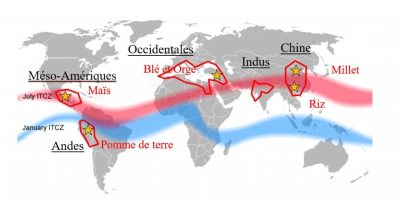
文森特·波奎奥(Vincent Boqueho)在其著作《耐气候文明》(Les civilisations à l’épreuve du climat)[1]中强调了季节性温度变化的重要性(一年中的某一时段低于某一阈值)。据他介绍,低温限制了几种由寄生虫携带、在高温下扩散的微生物源疾病的发展。高供水量、干湿交替、低温期这些条件的组合,大大缩小了有利于作物产量最大化的地理范围。在更大的区域尺度上,海拔升高有助于温度降低。图1作为波奎奥(Boqueho)的工作成果,一方面展示了得益于理想气候条件的地方性农业,另一方面展示了第一批辉煌文明出现的地区,二者在地理空间分布上有着惊人的重叠。
只有地中海文明超出了“新月沃土(fertile crescent)”,在更广阔的地区得到了发展。东方民族可能是在早期美索不达米亚文明剧变之后从中东迁移而来。对西方而言,直到在阿拉伯半岛北部建立起了第一个定居点后,这些民族才迁移到了地中海盆地这个十分利于海上贸易的地区。
无论是东方、西方、亚洲还是美洲印第安人,主要文明中心的位置在一定程度上都是由热带纬度区有利的气候条件所决定的。尤其是在地中海和山地气候中,这种情况更为常见。但是,这些气候条件在区域范围内也是有所波动的,尤其是与热带辐合带的季节波动有关。古气候的重建使我们能够确定不同地区的气候变化。我们是否能将这些变化与人口的变迁联系起来?在此,我们试图通过不同时期和不同大陆的例子,来说明气候的自然演变如何影响人类文明的建立、发展、衰退或迁移。
2. 过去千年气候带的迁移
这些文明的建立和发展发生于几千年前。第一个亚洲文明(第一次对水稻的精耕细作)和东部文明(美索不达米亚)出现于大约公元前(BC)5000年至4000年;第一个中美洲文明出现于公元前3000年至2000年。据此推算,这些(文明)定居点出现于距今7,000到4,000年的时期[2]。
理论上讲,本文所指的日期指的是公历(Gregorian calendar)(以 “零”年为基准,“公元前”(B.C.)和 “公元纪年”(A.D.)分别表示零年之前和之后的年份。)。这些年份也可以用相对于当前参照物的年限(age)来表示:B.P.(Before Present)表示使用公元1950年作为参考,B2K(Before Year 2000)以公元2000年为参考。因此,4000 BC对应为5950 BP。
如何重建过去这段时期的气候变化,这项工作对我们有何启示?根据自然档案,对过去的气候进行重建的科学家被称为古气候学家(paleoclimatologists)。在热带地区,这些专家们重点分析了过去几千年中不同时间尺度上热带辐合带(ITCZ)的迁移规律,并据此首次提出ITCZ在过去6000年中的整体向南迁移的观点(参考文献[2])。
最近,较短时间尺度(达数十年)的ITCZ迁移已被研究证实,特别是在所谓的冰河世纪早期(Early Ice Age)[3]。这时气候变化可以归因于许多因素,比如日照(sunstroke)的变化,一些大型火山的爆发,受到海洋和大气环流之间反馈机制的放大影响等等[4]。自距今6000年始,这个转折点就或多或少与前文所提到的最初的一些文明中心相对应,在那些地区,人们找到了适合自己发展的最理想的气候条件。而自然档案(如湖泊或海洋沉积物,或洞穴石笋)则证实了水平衡在这时发生了显著的变化,并且这些变化一定影响了人类赖以生存的农业资源。(那么,)又有哪些证据表明这些文明受到了气候变化的影响呢?
3. 苏美尔文明
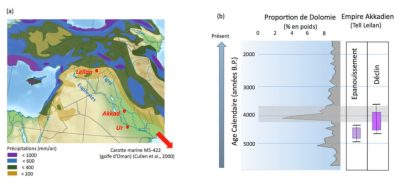
第一个案例是苏美尔文明,该文明曾在底格里斯河和幼发拉底河之间的美索不达米亚繁荣发展(图2a)。早在公元前7000年就有人占领了这个地区,远比公元前3500年左右苏美尔人的兴盛要早。苏美尔文明取得了一些人类文明史上的重大进步,比如车轮和楔形文字的发明,以及像乌鲁克这样的巨型城市的发展(图2a)。
为了养活城市居民,国家必须确保大量的农业生产。这一方面需要依赖文字(writing),因为文字可以更好地对资源进行统计和管理(例如农作物、场地、动植物统计);另一方面同样也依赖于河流的开发利用,以保证必要的水供应。这里的大河由位于安纳托利亚以东、肥沃新月北部的高加索(Transcaucasian)山脉提供水源(图2a)。目前,这些山脉每年的降水量在0.6到1米之间,足以形成大型河流(图2a)[5]。如果5500多年前的气候状况与今天的状况大致相同,那么这样的气候条件一定有助于当时农业的繁荣发展,从而推动苏美尔文明的进步。
苏美尔文明在公元前2334年左右经历了一个转折点:新统领萨尔贡国王把各个城市聚集在新首都阿卡德之下,建立了阿卡德帝国。然而,一个世纪后,也就是大约4100年前,这个帝国似乎遭遇了一次重大挫折。人们常用“阿卡德帝国的崩溃(collapse of the Akkadian empire)”一词来形容大城市在整个地区失去政治影响力,或是描述大型武力冲突和大量城市人口的流失。但通常来讲,4100年前后的这次崩溃并不是真正意义上的 “崩溃”,因为300年后该地区仍有阿卡德帝国统治的痕迹。
关于这段时期,气候记录对我们有何启示呢?地质记录表明,在现今叙利亚的拉兰遗址(Tell Leilan)地区[6]和阿曼湾的海洋沉积物中存在大量的粉尘沉积物(参考文献[5])。海洋沉积物的年代约为距今3900至4150年(图2b)。这些沉积物表明气候状况的迅速变干。一些文字记录描述了当时十分艰难的农业生产条件,表示重大的气候变化对农业产生了巨大的影响,从而影响阿卡德帝国的统治。从气候角度来看,美索不达米亚的干旱化与北大西洋表层海水的冷却有关,这种大气联系(atmospheric link)也已被证明适用于当前的气候。古气候记录显示,距今4100年左右北大西洋的温度下降了约1到2℃[7]。
当然,气候不是唯一导致阿卡德帝国衰落的原因。不过,这些重大的气候变化不可避免地对农业产生了影响,使其难以满足人们的需求。种种难题毫无疑问导致了城市之间的冲突和政治权力的不稳定。
这一气候事件似乎影响了整个热带区,其可进一步细分为距今4200年左右 和距今3900 年左右两个阶段[8],并导致了部分地区的干旱事件和另一些地区的强降雨事件。这些气候事件的影响规模如此之大,以至于它现在被用于定义一个最新的全新世分层地层参考点,命名为梅加拉亚期(Meghalayan)[9]。
4. 玛雅文明
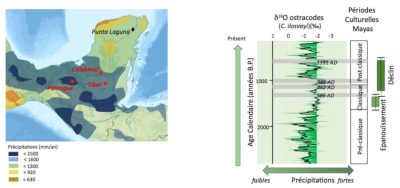
美洲大陆孕育了许多伟大的文明,它们随时间流逝在不同的地区接力更替。玛雅文明统治着整个尤卡坦半岛,即墨西哥南部的大部分区域(图3a)。历史学家确定了玛雅文明发展的三个阶段(图3b):
- 前古典时期(preclassical period):公元前2000年至公元250年;
- 古典时期(classic period):公元250年至公元900年,在该时期玛雅文明达到顶峰;
- 后古典时期(post-classical period):大城市开始衰落,人口流失并重新聚集在分散的村庄。这种衰弱促使北方民族,如托尔特克人的到来,并在半岛北部建立了新的城市。
在前古典时期,玛雅人在小村庄定居并开始改造环境。他们清理丛林并种植第一批以玉米为主的农作物。对于苏美尔和阿卡德文明来说,这种发展是由精确的文字系统和历法支持的,这使得他们能够更好地管理农业生产。
随着以“神王(king-divine)”为中心的强大政治和宗教统治的建立,蒂卡尔(Tikal)(图4)、卡拉克穆尔(Calakmul)或帕伦克(Palenque)等城邦(city-states)陆续出现,并试图在半岛各地区扩大其的统治范围。随后,这些城市之间开始了战争与同盟这样的微妙互动,建立了许多非凡的庙宇和金字塔,周围越来越多的居民也前来寻求庇护[11]。城市密度的增加使得农作物开垦面积扩大,这显然加速了古典时期的森林砍伐速度。
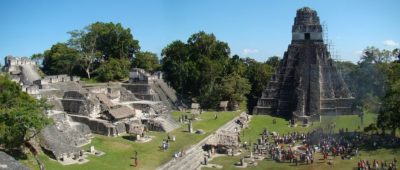
森林的砍伐使得半岛的地质基岩裸露出地表。这里是一个喀斯特石灰岩高原,雨水的渗透性很高。除非有大量的植物覆盖,土壤才能储存雨水。此外,中美洲这一地区的降水量直接取决于引言中介绍的热带辐合带(ITCZ)的地理位置。随着ITCZ的季节波动,该地区夏季为雨季,冬季为旱季(见图1和图3)。每年雨季的到来和大量土壤的存在,保证玛雅文明能最大限度地利用开发农业用地所必须的需水量。
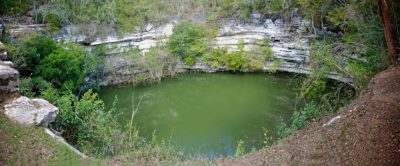
为了重建这种水平衡演化,(人们)收集了尤卡坦半岛北部[12][13]和中部[14][15]许多地点的湖泊沉积物,并在委内瑞拉北部收集了一些海洋沉积物[16]。这些记录证实在公元800年到900年之间这里存在数个持续数年至数十年的干旱时期(图3b)。这与ITCZ的南移,阻碍了夏季降雨向北以及玛雅土地的灌溉有关。尽管人工建造的储水设施以及天然水库“cenotes(天然井)”,已经让玛雅文明构建起了非常完善的地表储水系统,但严重的水文赤字还是影响了作物产量。事实上,历史学家也注意到在同一时间各“城邦”之间的政治紧张局势加剧,城市人口大量外流。尤卡坦中部地区大城市领导权的瓦解标志着古典时期的结束,一般也被视为玛雅文明的“崩溃(collapse)”。但“崩溃”这一术语在此无疑又是一种滥用,因为玛雅人和文化仍然存在,只是他们要么融入了诸如半岛北部的新文化之中,要么在孤立的小型聚落中生存。
与前一个案例的背景截然不同,如果气候变化不是文明不稳定的唯一原因,那么气候变化和文化剧变这两个事件的时间性耦合可能加速了人类社会运转的激变进程,使其可持续发展受到挑战。
5. 小冰期(Little Ice Age)的影响
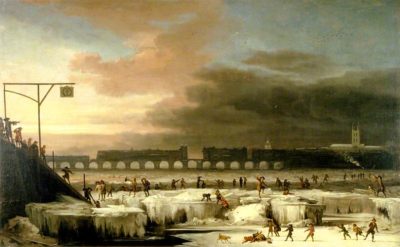
在小冰期,其它大陆上的文明也遭到了重创:如政治权力的丧失、持续的武装冲突以及部分人口流向其他地区。对环境记录的回顾帮助我们厘清这些文明遭受重创时的主要气候变化。我们发现:在格陵兰岛上的维京文明和柬埔寨高棉文明(其中的一座大城市拥有雄伟的吴哥寺庙)这两个文明中,人们都在13世纪左右毫不留情地抛弃了这些(文明所在的)地方。在这两个案例中,他们所遇到的经济问题(根源于政局不稳或简单的生存问题),也可以用重大的环境变化来解释(与所谓“小冰期”的气候变化有关)。
小冰期(图6)大约为14世纪到19世纪。在此期间,太阳活动减弱和强烈的火山爆发持续地影响着全球气候(包括降温)[17]。在14、15、17和18世纪太阳活动的持续减弱,加之火山喷发,导致了北大西洋温度显著下降和大气环流的改变这与几份气候档案均描述的ITCZ的南移有关。
5.1. 格陵兰岛的寒冷气候
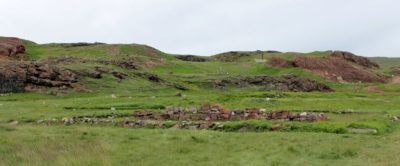
在约1000年的所谓中世纪温暖时期(medieval optimum period),维京人的祖先因政治事件(Eric the Red’s exile,红发埃里克的流放)被驱逐流放,并最终定居在当时气候条件适宜的格陵兰岛。这里有利的自然条件允许维京人建造带有牛羊牧场的村庄(图7)。
由于小冰期大气和海洋温度下降,冰川逐渐发展,这些在冰岛和格陵兰岛附近的冰盖和海洋沉积物等环境记录中都有记载。这些变化让维京人陷入困境:迫使他们要么选择改变生活方式和饮食习惯来适应环境变化,要么就得在公海(open sea)上寻找更适合的居住环境。他们曾尝试转向以渔业和海洋资源为基础的经济[19],但最终他们还是离开了这片不再适合生活的土地,返回到斯堪的纳维亚半岛或在美洲大陆的北部海岸殖民。格陵兰岛发现的最后一批维京人墓葬的日期大约在公元1430年左右(参考文献[18])。
5.2. 东南亚的干旱气候
在东南亚这个完全不同的(气候)背景中,高棉文明(Khmer civilization)曾遍布柬埔寨领土,并在吴哥遗址上建造了一流的建筑群。最早的建筑可追溯到9世纪。由于气候稳定,建筑的扩张速度随着12世纪吴哥窟(Angkor Wat,图8)和吴哥城(Angkor Thom)的修建而加快。人们在旱季和雨季的交替之中储存充足的雨水,用以灌溉农作物和养活不断增长的人口。正如在其他文明中所发现的那样(如第四部分中的玛雅文明),当时所建设的水利工程非常出色:多个面积超过50 km²的蓄水库与绵延数百公里的运河和堤坝网络相连。
从鼎盛时期到14世纪,高棉帝国的影响力辐射至东南亚的大部分国家。历史学家指出,大约在15世纪高棉帝国的统治力急剧下降,直到吴哥寺被弃置。这一衰落期大致相当于冰河世纪早期(Early Ice Age period)。
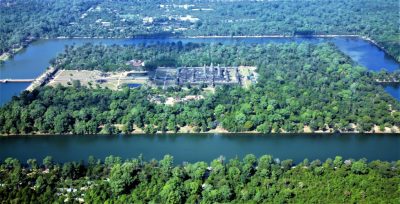
由于热带辐合带南移,东南亚地区的季风机制发生了变化,进而影响了该区的气候条件。中国地区几处石笋的化学研究和一个吴哥调整池(Angkor retention basins)沉积序列的详细研究均表明13、16和17世纪降水量显著下降[20][21]。连续的大旱,时而伴随着强降雨,可能严重破坏了水利网络,因为建在柔软地面上,此网络对水文变化非常敏感。农业生产和粮食供应受到影响,可能进一步导致了吴哥城市地区的人口大规模外流,以及当地政治和宗教力量的衰落。无论如何,这些气候变化和高棉帝国演变间的关联是非常显著的。
可以看出,由于地理位置不同,冰河世纪早期的气候变化有着不同的表现形式:北大西洋沿岸地区的气温降低,而东南亚地区则是降水量降低。据报道,在太平洋地区,新西兰山谷的冰川显著发展[22],而塔希提岛(Tahiti)[23]和加拉帕戈斯群岛(Galapagos archipelago)[24]则出现了暴雨。因此,小冰期对世界各地产生了截然不同的气候影响。
6. 重要的信息(Messages to remember)
- 环境的适应往往是定居的关键。当环境有利时,这种适应就更容易。
- 古往今来,许多大城市的发展都与自然资源,特别是淡水的可利用性和管理密切相关。对于热带地区来说,这种可利用性是最大降水区(ITCZ)季节性平衡的结果,它为这些地区提供了年复一年的水源。
- 气候记录表明,这种平衡的程度会随时间的推移而变化,并产生重大的水文影响。当时人们可以利用水利工程技术修建水库、调整池或灌溉渠等水利设施。这些设施已在帕伦克、蒂卡尔等玛雅城市和高棉城市吴哥被证明能够有效应对短期或中度气候灾害。
- 但当气候变化十分剧烈时,这些巧妙的应对(水利工程措施)是不够的。因此,大多数人移居到其他有利于他们发展的地方。
- 预计下个世纪的气候变化在全球范围内并不会是均质的。每一个地区都或多或少地会出现温度或水平衡的显著变化,以及海平面上升对沿海地区和三角洲的影响。这些地区的人们将有三种可能的选择:适应、迁移或消失。
对发达国家而言,一些农业适应措施已经在设想或正在实施中,例如培植新的葡萄品种来适应葡萄酒种植区(的气候变化);但另一方面,这些适应的成本可能不会由所有人(公平地)承担。此外,可能还会涌现出其它一些明智的储备政策。过去的人们制定了属于他们的适应战略,这些战略有的成功了,有的注定失败。如果某种弹性(resilience)措施可以在区域尺度乃至国家尺度内实现,那么在全球范围又将如何呢?
参考资料及说明
封面照片:位于墨西哥尤卡坦州奇琴伊察的玛雅考古遗址中,玛雅文明鼎盛时期的库库尔坎(Kukulkán)金字塔,也被称为El Castillo [来源:© B. Malaizé, 2010]
[1] BOQUEHO V. Les civilisations à l’épreuve du climat, Dunod, “Quai des sciences”, 2012, 192 p.
[2] Wanner H., Beer J., Bütikofer J., Crowley T.J., Cubasch U., Flückiger J., Goosse H., Grosjean M., Joos F., Kaplan J. O., Küttel M., Müller S. A., Prentice I. C., Solomina O., Stocker T. F., Tarasov P., Wagner M. and Widmann (2008), Mid-to Late Holocene climate change: an overview, Quaternary Science Reviews, 27(19-20), 1791-1828. doi:10.1016/j.quasi-cirev.2008.06.013.
[3] Lechleitner F.A., Breitenbach S. F.M., Rehfeld K., Ridley H. R., Asmerom Y., Prufer K.M., Marwan N., Goswami B., Kennett D.J., Aquino V.V., Polyak V., Haug G.H, Eglinton T. and Baldini J. U.L. (2017) Tropical rainfall over the last two millennia: evidence for a low-latitude hydrologic seesaw, Nature Comm., doi:10.103B/srep45809.
[4] Schurer A. P., Tett S.B.F., Hegerl G.C. (2014). Small influence of solar variability on climate over the past millennium. Nature Geosciences, 7: 104-108.doi:10.1038/ngeo2040.
[5] Cullen H.M., deMenocal P.B., Hemming S., Hemming G., Brown F.H., Guilderson T. and Sirocko F. (2000), Geology, vol 28, n4, 379-382.
[6] Weiss H., Courty M-A., Wetterstrom W., Guichard F., Senior L., Meadow R. and Curnow A. (1993), vol 261, pp 995-1004, doi: 10.1126/science.261.5124.995.
[7] deMenocal P. B. (2001), Cultural responses to climate change during the Late Holocene, Science, 292, 667, doi: 10.116/science.1059827.
[8] Railsback L. B., Liang F., Brook G. A., Voarintsoa N. R. G., Sletten H. R., Marais E., Hardt B., Cheng H. and Edwards R. L. (2018), The timing, two-pluse nature, and variable climatic expression of the 4.2 ka event : A review and new high resolution stalagmite data from Namibia, Quat. Sci. Rev., 186, 78-90.
[9] Event recently ratified by the International Commission on Stratigraphy (ISQS, 2018).
[10] Curtis J.H., Hodell D. A. and Brenner M. (1996), Climate variability on the Yucatan peninsula (Mexico) during the past 3500 years, and implications for Maya Cultural evolution, Quat. Res, 46, 37-47.
[11] Martin S. and Gruβe N., Chronicle of the Maya kings and Queens, Thames and Hudson, 2005, 240p.
[12] Curtis J.H., Hodell D. A. and Brenner M. (1996), Climate variability on the Yucatan peninsula (Mexico) during the past 3500 years, and implications for Maya Cultural evolution, Quat. Res, 46, 37-47.
[13] Hodell D. A., Brenner M., Curtis J. H., Medina-Gonzalez, Ildefonso-Chan Can E., Albomaz-Pat A. and Guilderson T. (2005), Climate change on the Yucatan peninsula during the Little Ice Age, Quat Res., 63, 109-121. Doi:10.1016/J.yqres.2004.11.004.
[14] Rosenmeier M. F., Hodell D. A., Brenner M. and Curtis J. H. (2002), A 4000 year lacustrine record of environmental change in the Southern Maya Lowlands, Peten, Guatemala, Quat. Res. 57, 183-190. doi:10.1006/qres.2001.2305.
[15] Fleury S., B. Malaizé, J. Giraudeau, D. Galop, V. Bout-Roumazeilles, P. Martinez, K. Charlier, P. Carbonel and C. Arnauld (2014) “Impacts of Maya land use on Laguna Tuspan watershed (Peten, Guatemala) as seen through clay and ostracode analysis”. Jr Archaeo Sc., 49, 372-382.
[16] Haug G.H., Günther D., Peterson L.C., Sigman D.M., Hughen K. A. and Aeschlimann B. (2003), Climate and the collapse of the Maya civilization, Science, vol. 299, 1731-1735.
[17] Schurer A. P., Tett S.B.F., Hegerl G.C. (2014). Small influence of solar variability on climate over the past millennium. Nature Geosciences, 7: 104-108.doi:10.1038/ngeo2040.
[18] Lechleitner F.A., Breitenbach S. F.M., Rehfeld K., Ridley H. R., Asmerom Y., Prufer K.M., Marwan N., Goswami B., Kennett D.J., Aquino V.V., Polyak V., Haug G.H, Eglinton T. and Baldini J. U.L. (2017) Tropical rainfall over the last two millennia: evidence for a low-latitude hydrologic seesaw, Nature Comm., doi:10.103B/srep45809.
[19] Arneborg J., Heinemeier J., Lynnerup N., Nielsen H., Rud N. and Sveinbjörnsdottir A.E., (1999), Change in the diet of the Greenland vikings determined from stable carbon isotope analysis and 14C dating of their bones, Radiocarbon, Vol 41, 157-168.
[20] Zhang P., Cheng H., Edwards R. L., Chen F., Wang Y., Yang X., Liu M., Tan M., Wang X., Liu J., An C., Dai Z., Zhou J., Zhang D., Jia J., Jin L. and Johnson K. R., (2008), A test of climate, sun and culture relationship from an 1810-year Chinese cave record, Science, vol 322, 940-942, doi: 10.1126/science.1163965
[21] Day M.B., Hodell D. A., Brenner M., Chapman H.J., Curtis J. H., Kenney W. F., Kolata A. L. and Peterson L., (2011), Paleoenvironmental history of the West Baray, Angkor, Cambodia, PNAS, vol 109, 1046-1051, doi: 10.1073/pnas.1111282109.
[22] Schaefer J.M., Denton G. H., Kaplan M., Putnam A., Finkel R.C., Barrell D. J. A., Andersen B. G., Schwartz R., Mackintosh A., Chinn T and Schlüchter C., (2009), Hign frequency Holocene Glacier fluctuations in New Zealand differ from the Northern Signature, Science, vol 324, 622-625, doi:10/1126/science.1169312.
[23] Orliac M. (1986), A la recherche des anciens polynésiens, Tahiti et Moorea, in’Encyclopedie de la Polynésie, Vol 4, p82-83, ed C. Glizal/ les éditions de l’Alizé.
[24] Nelson D. B. and Sachs J. P. (2016), Galapagos hydroclimate of the common Era from paired microalgal and mangrove biomarker 2H/1H values, PNAS, vol 113 3476-3481, doi: 10.1073/pnas.1516271113.
环境百科全书由环境和能源百科全书协会出版 (www.a3e.fr),该协会与格勒诺布尔阿尔卑斯大学和格勒诺布尔INP有合同关系,并由法国科学院赞助。
引用这篇文章: MALAIZE Bruno (2024年3月13日), 气候变化与古代文明, 环境百科全书,咨询于 2024年4月25日 [在线ISSN 2555-0950]网址: https://www.encyclopedie-environnement.org/zh/climat-zh/climate-change-and-ancient-civilizations/.
环境百科全书中的文章是根据知识共享BY-NC-SA许可条款提供的,该许可授权复制的条件是:引用来源,不作商业使用,共享相同的初始条件,并且在每次重复使用或分发时复制知识共享BY-NC-SA许可声明。







